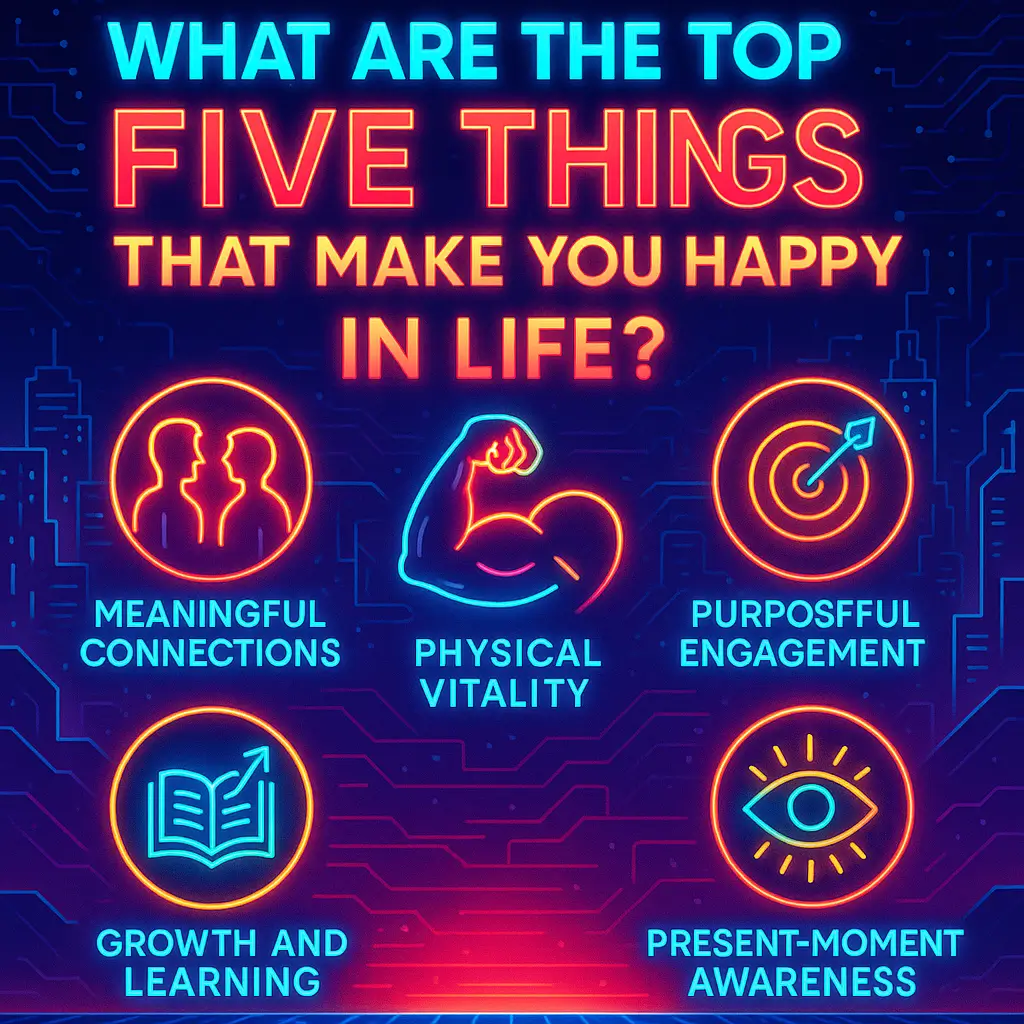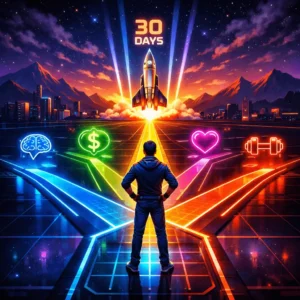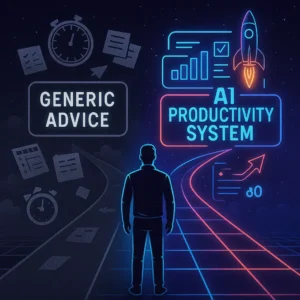Have you ever wondered why some people seem naturally joyful while others struggle to find contentment, even when their lives appear successful from the outside? The answer isn’t what most self-help content would have you believe. The secret to understanding what are the top five things that make you happy in life isn’t found in universal lists or one-size-fits-all advice. It’s discovered through a deeply personalized approach that considers your unique personality, lifestyle, and goals.
Most happiness advice treats everyone as if they have identical emotional needs and life circumstances. But what brings joy to an introverted artist living alone will be vastly different from what fulfills an extroverted parent managing a household. This is where artificial intelligence and personalized assessment become game-changers. They help you identify your specific happiness drivers rather than following recommendations that may not align with who you are.
The breakthrough comes when you stop chasing someone else’s definition of happiness and start building your own blueprint for joy. This approach goes beyond surface-level mood boosters to address the areas of life that contribute most to lasting fulfillment. By the end of this guide, you’ll have both the framework and the tools to identify your unique happiness formula.
Key Upgrades You’ll Get From This Blog
Reading and implementing the insights from this comprehensive guide will provide you with several transformative upgrades:
- Enhanced Emotional Intelligence and Self-Awareness – You’ll develop a deeper understanding of what truly drives your happiness.
- Practical Toolkit for Daily Joy – You’ll have concrete methods to boost your mood whenever needed.
- Improved Relationship Quality and Life Satisfaction – Understanding the fundamental role of meaningful connections in happiness
Why Most Happiness Advice Leaves You Feeling Empty
The self-help industry is flooded with generic happiness prescriptions that promise universal results. “Exercise more,” “practice gratitude,” “connect with others”—while these aren’t wrong, they’re incomplete. They fail to account for the crucial reality that simple things that make you happy vary dramatically from person to person based on your natural temperament, life stage, and circumstances.
Consider two people trying to implement the common advice to “spend more time in nature.” For someone who finds energy in solitude and quiet reflection, a solo hike might be transformative. But for someone who thrives on social connection, that same solo experience might feel lonely and draining. The activity is the same, but the personal happiness impact is completely different.
This personalization gap explains why so many people try happiness strategies that work for others, only to feel frustrated when those same approaches fall flat in their own lives. Without understanding your unique happiness profile, you’re essentially playing a guessing game with your well-being.
The little things that make you happy are deeply personal and often overlooked because they don’t fit into conventional happiness frameworks. Maybe you find joy in organizing your workspace, solving complex problems, or having deep one-on-one conversations. These specific preferences are clues to your unique happiness blueprint, but traditional advice rarely helps you identify and leverage them.
Read More: How to Stop Pretending to Be Happy
Using AI to Discover Your Personal Happiness Blueprint
Before exploring key areas for lasting joy, use AI to discover what makes you happy.
This brief AI-powered assessment helps personalize everything that follows.
AI PROMPT TO COPY/PASTE:
“I want to understand my personal happiness patterns and identify what specifically brings me joy. Please act as a behavioral analyst to help me create my unique happiness profile.
Please guide me through this process step by step, waiting for my response before moving to each next stage:
First Step: Happiness Pattern Recognition
- Describe three recent moments when you felt genuinely happy or content. What was happening, who was present, and what made these moments special? a. Example: “I felt happiest while cooking dinner with my partner, listening to music, and talking about our day.”
- Think about your energy levels throughout the day. When do you typically feel most positive and engaged? a. Example: “I’m most positive in the mornings after coffee and exercise.”
Second Step: Personal Joy Triggers
- What activities make you lose track of time in a positive way?
- Do you gain energy from social interactions or quiet solitude?
- What environments make you feel most at peace?
Based on my responses, please identify my top happiness triggers and suggest which of the five core happiness areas might be most impactful for my personality type.”
Sample AI Dialogue: AI: “Based on your responses, you seem to find happiness through creative expression combined with meaningful relationships. You’re energized by collaborative activities and prefer environments that stimulate your senses. This suggests focusing first on purposeful activities and social connections might give you the biggest happiness boost.”
User: “That resonates completely. I do feel most alive when I’m working on creative projects with people I care about.”
What Are the Top Five Things That Make You Happy in Life?
The Five Core Areas of Lasting Happiness (Personalized to You)
Now that you understand the importance of personalization, let’s explore the five fundamental areas that research consistently shows contribute to what are the top five things that make you happy in life. Unlike generic advice, each area includes specific ways to customize your approach based on your unique preferences and circumstances.
1. Meaningful Connections (Tailored to Your Social Style)
Relationships consistently rank as the top source of human happiness, but the type and depth of connections that bring you joy depend entirely on your personality and life situation. The Harvard Study of Adult Development found that relationship quality matters more than quantity, which means your social happiness strategy should align with your natural interaction style.
For introverts, meaningful connections might mean having deep, one-on-one conversations with a few close friends. For extroverts, happiness might come from being part of larger social groups and community activities. Neither approach is superior—they’re simply different paths to the same destination of human connection.
The key is identifying your optimal social “dose.” Some people thrive with daily social interaction, while others need significant alone time between social engagements to recharge. Understanding your social battery helps you design a relationship life that energizes rather than drains you.
Simple things that make you happy in relationships often include regular check-ins with people you care about, sharing experiences that align with your interests, and having others recognize and appreciate your unique qualities. These personalized connection strategies work better than forcing yourself into social situations that don’t match your natural preferences.
Read More: How to Heal from a Toxic Relationship
2. Physical Vitality (Matched to Your Body and Lifestyle)
Physical health provides the foundation for all other sources of happiness, but the specific activities that make you feel strong and energized vary widely. The goal isn’t to follow someone else’s fitness routine—it’s to find movement and nutrition patterns that make your body feel good and fit naturally into your life.
Some people find joy in high-intensity workouts that provide an endorphin rush and sense of accomplishment. Others prefer gentle, meditative activities like yoga or walking that combine physical movement with mental clarity. Your exercise personality determines which approach will actually stick and bring you happiness rather than feeling like a chore.
Sleep quality is equally personal. While everyone needs adequate rest, your optimal sleep schedule, environment, and routine depend on your natural circadian rhythms and life circumstances. A parent with young children will have different sleep strategies than a night-shift worker or someone living in a studio apartment.
Nutrition happiness comes from finding foods that both nourish your body and satisfy your psychological relationship with eating. This might mean meal prep for someone who finds comfort in routine, or flexible eating for someone who enjoys culinary exploration and variety.
3. Purposeful Engagement (Aligned with Your Values and Strengths)
Having a sense of purpose gives life direction and makes challenges feel worthwhile, but purpose looks different for everyone. It doesn’t require a grand mission—it can be as specific as being an excellent parent, mastering a craft, or contributing to your local community in ways that utilize your unique strengths.
Your purpose often lies at the intersection of what you’re naturally good at, what energizes you, and what feels meaningful based on your values. Someone with analytical strengths might find purpose in solving complex problems, while someone with interpersonal gifts might find meaning in helping others navigate challenges.
Little things that make you happy often provide clues to your larger purpose. If you consistently find joy in organizing, teaching others, creating beautiful things, or solving problems, these preferences point toward activities and roles that could bring deeper fulfillment when pursued more intentionally.
The key is recognizing that purpose can be found in any role or activity when it aligns with who you are. A teacher finds purpose in education, but so can an accountant who helps small businesses thrive, or a parent who creates a nurturing home environment.
Read More: 15 Questions to Discover Your Life Purpose
4. Growth and Learning (Customized to Your Learning Style)
Humans are naturally curious, and the process of developing new capabilities provides deep satisfaction. However, the types of learning that energize you depend on your interests, learning preferences, and current life stage. Understanding your growth personality helps you choose development activities that feel exciting rather than overwhelming.
Some people thrive on intellectual challenges like reading complex books, taking courses, or engaging in philosophical discussions. Others find fulfillment in hands-on learning like crafts, cooking, or physical skills. Creative learners might prefer artistic expression, while systematic learners enjoy structured skill-building.
Personal growth also includes emotional and social development. This might mean becoming more self-aware, developing better communication skills, or learning to manage stress more effectively. The specific growth areas that bring you happiness often relate to challenges you’re currently facing or strengths you want to develop further.
Psychological tricks to make yourself happy often involve connecting new learning to immediate applications in your life. When growth feels relevant and useful, it becomes inherently more rewarding and sustainable.
Read More: Self Reflection Questions for Growth
5. Present-Moment Awareness (Practiced in Ways That Fit Your Personality)
The ability to appreciate what you have and stay present in positive moments amplifies every other source of happiness. However, mindfulness and gratitude practices work best when they match your personality and lifestyle rather than following rigid formulas.
Some people find peace in formal meditation practices, while others discover mindfulness through activities like gardening, cooking, or walking. The goal is developing present-moment awareness in ways that feel natural and sustainable for you.
Gratitude practices can be as simple as mentally noting three good things each day, or as elaborate as keeping a detailed gratitude journal. Some people prefer sharing appreciation with others, while others find private reflection more meaningful. The effectiveness comes from consistency and personal resonance, not from following a specific format.
Simple things that make you happy often become more noticeable and impactful when you develop the skill of present-moment awareness. The warmth of morning sunlight, the taste of your favorite meal, or the sound of laughter all become sources of regular joy when you train yourself to notice and appreciate them.
Advanced Strategies for Sustainable Happiness
Once you understand your personal happiness profile across these five core areas, you can implement advanced strategies that create compounding positive effects. These approaches go beyond individual happiness habits to create an integrated system of well-being.
The ripple effect is particularly powerful—improvements in one area naturally enhance the others. When you engage in purposeful work that aligns with your strengths, you’ll likely feel more energized (physical vitality), have more interesting things to discuss with others (meaningful connections), learn new skills (growth), and feel more satisfied with your daily experience (present-moment awareness).
Creating what researchers call “happiness stacking” involves intentionally combining elements from multiple areas. This might mean taking a cooking class (growth) with a friend (connection) that helps you prepare healthier meals (physical vitality) while learning about a culture you’re curious about (purpose) and practicing mindfulness through focused attention on the cooking process (present-moment awareness).
The key is building these integrated experiences gradually, starting with small experiments that align with your personality and lifestyle. What works for one person might feel forced or overwhelming for another, which is why personalization remains crucial.
Read More: 100 Things to Be Grateful For
Beyond Individual Happiness: The Limitations of DIY Approaches
While self-directed happiness strategies can create meaningful improvements, they have inherent limitations. Most people struggle with consistency, accountability, and adapting their approaches as their lives evolve. Additionally, individual effort often misses the power of community support and expert guidance in maintaining long-term positive changes.
Furthermore, true happiness often requires changes that extend beyond individual practices to include environmental design, social connections, and systematic approaches to personal growth. These broader transformations benefit from structured support and proven frameworks that have helped others successfully navigate similar journeys.
Conclusion: 5 things that make you happy
Understanding what are the top five things that make you happy in life is just the beginning of your happiness journey. The real transformation comes from consistently implementing personalized strategies across all five core areas while building the systems and support structures that make positive changes sustainable over time.
Remember that happiness isn’t a destination but a process of aligning your daily life with what brings you genuine fulfillment. The simple things that make you happy and little things that make you happy are often the building blocks of larger positive changes, providing both immediate mood boosts and long-term satisfaction when practiced consistently.
Your personal happiness blueprint is unique to you, but you don’t have to build it alone. The most successful people recognize when they need structured support, proven frameworks, and community accountability to turn their insights into lasting positive change.
Ready to Transform Your Understanding Into Lasting Change?
While this guide provides the foundation for understanding your personal happiness drivers. Implementing and maintaining these insights requires more than individual effort alone. This is where a comprehensive, science-backed system becomes invaluable.
The Habits Coach AI represents the next evolution in personalized happiness and life transformation. Unlike generic self-help approaches, MM combines AI-powered personalization with behavioral science and proven principles to create a tailored journey across all five core areas of lasting happiness: Mindset, Career & Finances, Relationships, Physical Health, and Emotional & Mental Health.
The MM System addresses the key limitations of DIY happiness approaches:
- Personalized AI Guidance: Get tailored strategies based on your unique personality, lifestyle, and goals rather than following generic advice that may not fit your circumstances
- Science-Backed Implementation: Apply proven behavioral science techniques that make positive changes feel effortless rather than relying on willpower and motivation
- Holistic Integration: Create ripple effects across all five happiness areas instead of working on isolated improvements that don’t reinforce each other
- Gamified Accountability: Stay engaged through rewards, progress tracking, and community support that make growth feel like an exciting game rather than tedious work
- Continuous Adaptation: Evolve your approach as your life changes, ensuring your happiness strategies remain relevant and effective over time
Don’t let another year pass wondering what are the top five things that make you happy in life without taking action to build them systematically. The insights you’ve gained from this guide are the foundation. Now it’s time to build the complete structure of lasting joy and fulfillment.
Start your transformation today:
- Take our free Core Values Assessment to identify where you stand across all five happiness areas
- Discover your personalized Golden Habits using our AI-powered Habits Hierarchy System
- Join thousands of others who have transformed their daily experience from routine to remarkable






